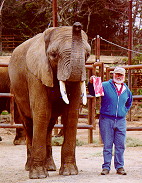

A small metal sign identifies the dirt road that will take you to Riddle's Elephant Breeding Farm and Wildlife Refuge, which is located a couple of miles down that dirt road off highway 25 between Guy and Quitman. The place is not open to the public except during regular open houses 11:00am to 2:00pm the first Saturday of every month. I attended the open house on 2/7/98, and that can only mean it was Hank's tenth birthday party.
 These are Hank and company, anticipating devouring a couple of "birthday cakes" made of bales of hay decorated with fresh fruits and vegetables. The birthday boy, like most of the elephants on the ranch, is here because somewhere along the line there was trouble.
These are Hank and company, anticipating devouring a couple of "birthday cakes" made of bales of hay decorated with fresh fruits and vegetables. The birthday boy, like most of the elephants on the ranch, is here because somewhere along the line there was trouble.
When a circus or carnival or a zoo closes down, what happens to the elephants? If they're lucky they come to Arkansas. If they're not, well they don't. What happens if an elephant in a zoo or circus proves too headstrong or too difficult to handle for the regular staff? What happens if an elephant herd is thinned, leaving a motherless calf? If it's lucky it comes to Arkansas. If it's not, well it doesn't. All too often such unwanted elephants are euthanized.
 That guy in the blue coat and white cap is Chris. He's an elephant trainer trainer (Yes, I intentionally wrote that word twice.), and for a price he'll teach you how to handle elephants. Every year, in addition to teaching elephant handling skills here and there around the globe, Mr. Riddle's staff teaches two summertime classes right here on the ranch. One program is tailored to professional animal handlers, zoo personnel, circus performers and the like; and another two-week session is arranged for hobbyists. The bearded man in the army jacket is Gordon McIntyre, coordinator of a large and dedicated volunteer staff which tends (with shovel and wheelbarrow) the ten Asian and African elephants now in residence at Riddle's place. The hooded figure...a jedi master.
That guy in the blue coat and white cap is Chris. He's an elephant trainer trainer (Yes, I intentionally wrote that word twice.), and for a price he'll teach you how to handle elephants. Every year, in addition to teaching elephant handling skills here and there around the globe, Mr. Riddle's staff teaches two summertime classes right here on the ranch. One program is tailored to professional animal handlers, zoo personnel, circus performers and the like; and another two-week session is arranged for hobbyists. The bearded man in the army jacket is Gordon McIntyre, coordinator of a large and dedicated volunteer staff which tends (with shovel and wheelbarrow) the ten Asian and African elephants now in residence at Riddle's place. The hooded figure...a jedi master.
 This gentleman with the white beard is Scott Riddle, the alpha male of this operation. Formerly with Ringling Brothers, he has 25 years of experience handling elephants. In his hand is a painting by Mary, an Asian elephant. I asked one of the volunteers about it, and she told me that one of the trainers one day noticed Mary scratching in the dirt with a stick. They gave her a brush, paint and canvas and she took care of the rest. You can buy her paintings at the Riddle ranch or at the Cantrell Gallery in Little Rock. Expect to spend up to $350. What the heck, it all goes to the elephants.
This gentleman with the white beard is Scott Riddle, the alpha male of this operation. Formerly with Ringling Brothers, he has 25 years of experience handling elephants. In his hand is a painting by Mary, an Asian elephant. I asked one of the volunteers about it, and she told me that one of the trainers one day noticed Mary scratching in the dirt with a stick. They gave her a brush, paint and canvas and she took care of the rest. You can buy her paintings at the Riddle ranch or at the Cantrell Gallery in Little Rock. Expect to spend up to $350. What the heck, it all goes to the elephants.
The constant scramble for cash makes the Riddles put the elephants to work earning their own keep whenever possible. In addition to hawking novelty artwork, you can get elephant rides for parties, go on an Ozark Mountain elephant safari, or take one of the aforementioned elephant-handling courses. You can even adopt an elephant for a hundred bucks a year instead of one of those third-world orphans you see on those commercials late at night on TV ("Sponsor this child or she will die and it will be YOUR FAULT."). For your money, you get a subscription to the sanctuary's newsletter, a photo of your elephant, a certificate of sponsorship, and an "ASK ME ABOUT MY ELEPHANT" bumber sticker.
It cost's just over a hundred bucks a week to feed one of these elephants--about $15,000 a year to feed Riddle's herd. That doesn't include the cost of housing them or the veterinary bills or incidentals at which I can only guess.
Scientists also conduct research at the ranch. The details of said research are a little disgusting, so parties interested in elephant emission research should contact Tom Goodwin at the Department of Chemistry, Hendrix College.
RTJ-3/1/98